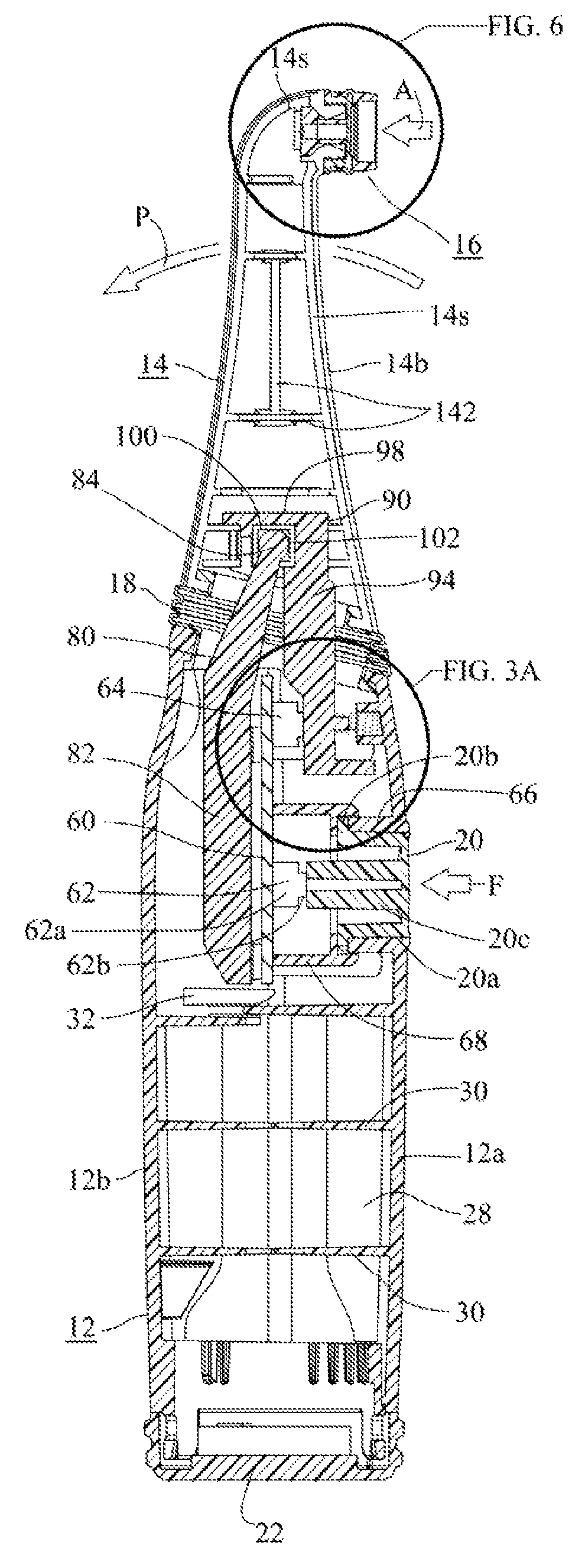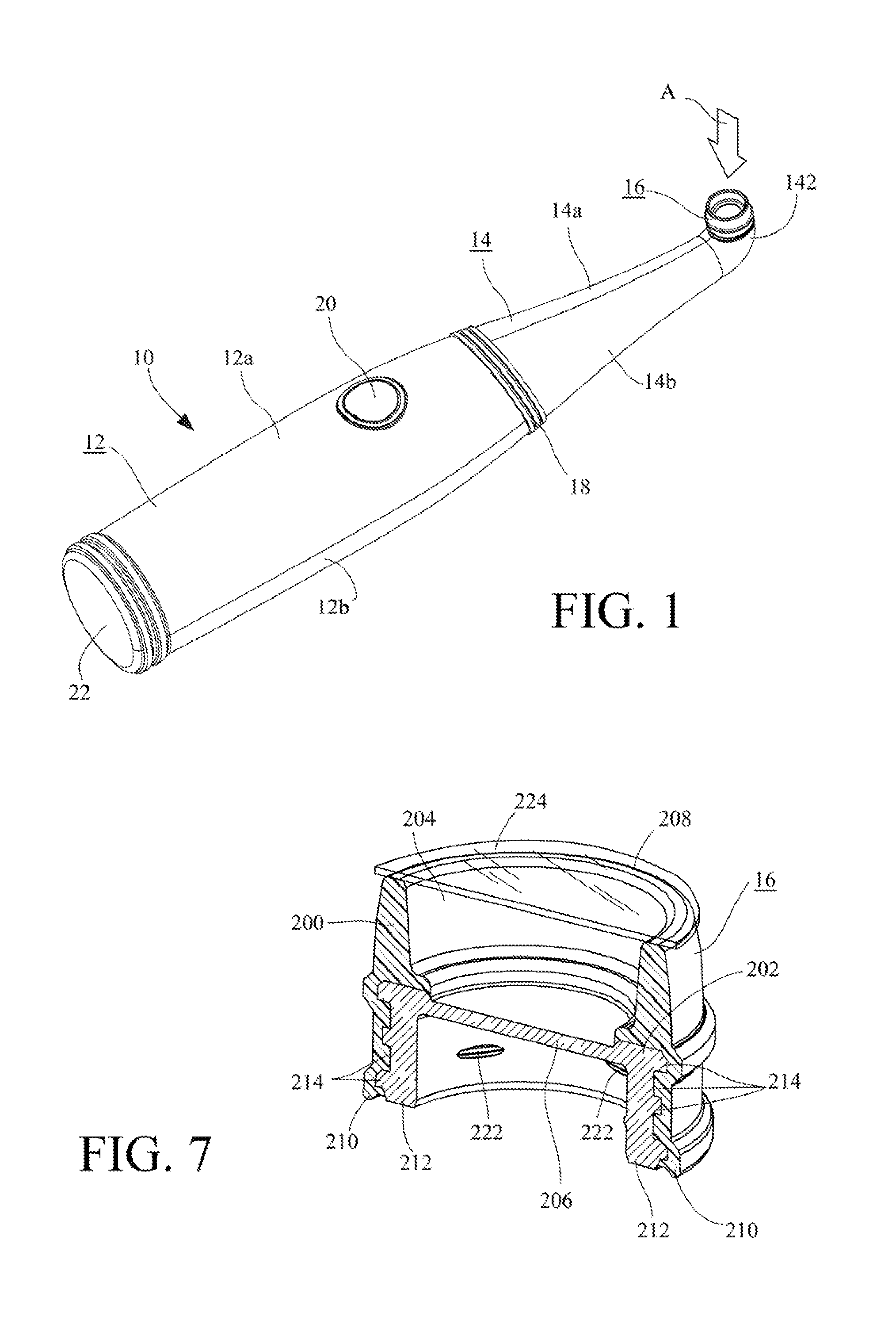Hand-held tooth whitening instrument with applicator reservoir for whitening composition and methods of using same
a technology of whitening composition and whitening instrument, which is applied in the field of hand-held devices for whitening teeth, can solve the problems of tooth sensitization in over 50% of patients, intractable intrinsic staining, damage to pulpal tissue, etc., and achieve the effect of reducing the number and types of oral pathogens and reducing the number of oral borne pathogens
- Summary
- Abstract
- Description
- Claims
- Application Information
AI Technical Summary
Benefits of technology
Problems solved by technology
Method used
Image
Examples
example 1
Measurement of Light Energy
[0095]This example reports the results of the measurement of the light energy emitted from an instrument with the salient features of the instrument 10 described above constructed in accordance with the above principles. As described above in connection with a preferred embodiment, the LED 110 of the instrument tested was a Luxeon® Rebel LXML-PR01-0500 royal blue light emitting diode (Philips Lumileds Lighting Co., San Jose, Calif.), with a nominal output rating of 500 milliwatts at 350 mA, that emits blue light comprising wavelengths between 400 nm and 500 nm, with a peak wavelength of approximately 455 nm. The light emitting surface of the LED was approximately 7 mm from the surface being treated, and the applicator cup 16 contained the transparent gel described in Example 2. The reservoir window 206 had a diameter of 8 mm, and the reservoir distal end 208 was spaced 2 mm from the window along the axis of the cylindrical sleeve 200. The flexible sleeve w...
example 2
Preparation of a Tooth Whitening Gel
[0098]A representative tooth whitening gel comprising hydrogen peroxide and having a transparency of 95% was prepared by combining the ingredients listed in Table 1 below in a vacuum mixer. The resulting gel was visually transparent and colorless, had a pH of approximately 6.5 when measured neat without dilution, and had a viscosity of approximately 70,000 centipoise. This gel was used in Examples 3 and 4 below to demonstrate the tooth whitening ability and / or enhancement provided by employing principles of the present invention.
[0099]
TABLE 1IngredientPercent (wt.)Deionzied water57.300Glycerin20.0001-hydroxyethylidine-1,1-diphosphonic acid0.500Potassium stannate0.100Sodium saccharin0.600Hydrogen peroxide12.000Carbopol 974P3.000PEG-60 hydrogenated castor oil3.000Flavor1.000Ammonium hydroxide (29% solution)2.500Total100.000
example 3
Comparative Removal of Tooth Stains in an In Vitro Model
[0100]In accordance with a commonly used technique for in vitro testing of tooth whitening compositions, this example used a series of stained bovine enamel slabs to test the efficacy of the light-emitting instrument 10 described in Example 1 above using the tooth whitening gel composition described in Example 2 in removing or destroying stains on tooth enamel. Slabs providing a Control baseline were contacted with a non-active tooth whitening composition (the composition of Example 2 without hydrogen peroxide). A second set of slabs was contacted with the tooth whitening gel of Example 2 alone, but without exposure to light. A third set of slabs (referred to in Table 2 below as “Gel+Light”) was treated with tooth whitening gel of Example 2 using the instrument described in Example 1 to apply light energy through the tooth whitening composition contained in the applicator cup 16 of the instrument. The treatment time for each te...
PUM
 Login to View More
Login to View More Abstract
Description
Claims
Application Information
 Login to View More
Login to View More - R&D
- Intellectual Property
- Life Sciences
- Materials
- Tech Scout
- Unparalleled Data Quality
- Higher Quality Content
- 60% Fewer Hallucinations
Browse by: Latest US Patents, China's latest patents, Technical Efficacy Thesaurus, Application Domain, Technology Topic, Popular Technical Reports.
© 2025 PatSnap. All rights reserved.Legal|Privacy policy|Modern Slavery Act Transparency Statement|Sitemap|About US| Contact US: help@patsnap.com



